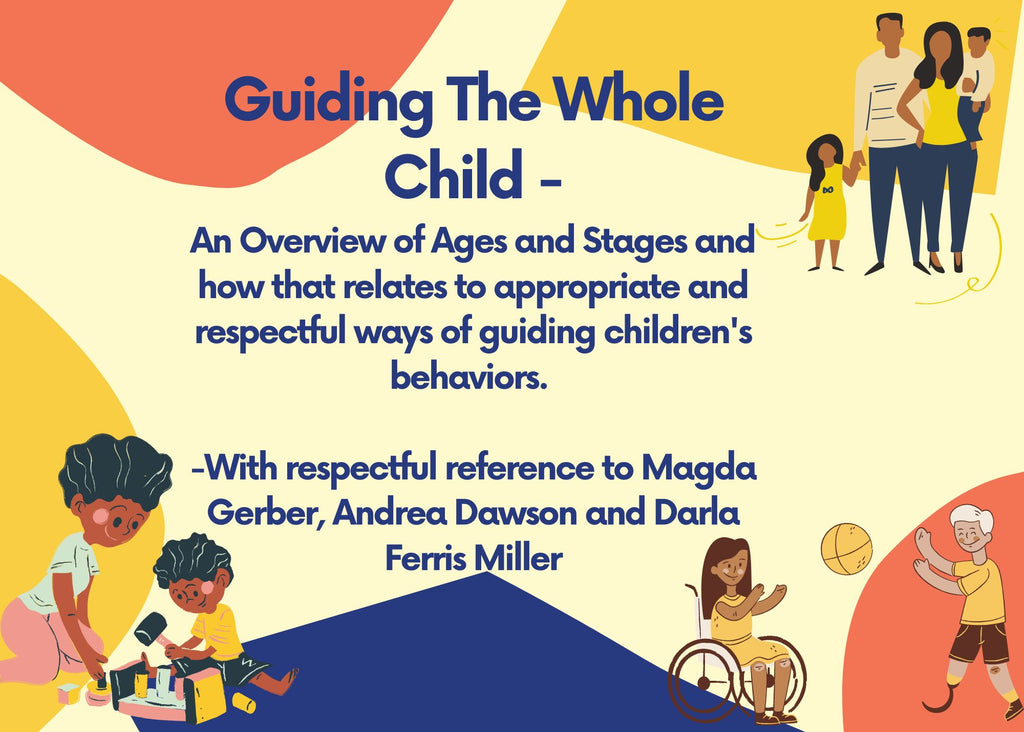Guiding the Whole Child

Welcome to our first blog post following "The Nook," our free weekly gathering for parents/caregivers featuring guest speakers on all things family-related and a cozy, caring place to listen, share or just BE. Check "The Nook" on our Events page for upcoming speakers.
Our first speaker was our own Jessica Schellenberg, speaking on Guiding the Whole Child.
The first year of life a child's job is to be decoding the world in a curious, sensory-based way. We are helping them by providing food, sleep and a safe, nurturing and stimulating environment. They are natural-born learners, very capable and confident in their own right. As long as the environment we are providing is safe and age appropriate there is very little need for correction of behaviour. Gentle redirection by providing an interesting toy or some one on one time is usually all that is necessary. Positive redirection remains a useful tool over the next several months.
As we look ahead, at around 8 months we engage our babies in the actions we are doing with language cues, "I'm cleaning up now. I'm putting the toys in the basket." And by around 12 months, "It's time to clean up now."
Toddlers (12-36 months) want our attention. It is very helpful to change our mindset from my child has hit "the terrible twos" to they are doing exactly what they are supposed to be doing at this age. They are exploring their likes and dislikes; they are learning to communicate, and they are feeling big feelings that they don't necessarily have the language to express.
Keeping these ideas in mind we turn to the philosophy of Positive Guidance.
Positive Guidance is a language strategy that empowers the child but also help us set limits. By stating limits and expectations in a clear and positive way, we decrease resistance and increase resilience.
A moment of struggle with a child reminds us to focus on the separation of child and behaviour. When a child is demonstrating challenging behaviour, a need is being communicated.
Language is positive, but limits are still being communicated. Eg. "I hear that you need a cookie. You can have one after dinner." or even "I hear you want a cookie, but we will have one another day."
There are situations where safety demands an immediate, negative response. "Stop! Don't put that in your mouth!" but these situations can be reduced by forming a habit of positive framing.
When challenging behaviour arises, first turn challenge into opportunity for connection by acknowledging what your child is feeling. Next, set any necessary limits and whenever possible create an environment where the challenge is eliminated.
An example, you are folding the laundry and your child is knocking over the piles of clean laundry.
First, involve your child in what you are doing, "i'm folding the laundry. Can you find all the socks that are yours?"
If the task is taking too long to hold their interest or they are tired, hungry or needing your attention and you need to finish the job, use simple language - 5 to 6 words and state your expectation clearly, "I understand you need to eat." "In two minutes I will be finished." Then remove the laundry.
Decide what behaviours you want to engage in and what is appropriate to ignore for the moment. Never compare your child to another. Each child is learning something unique at any given moment and remember that separating the behaviour from the child is key.
Honour what is needed in the moment.
From 3-5 years children are not built to stay still. Parents may feel their child is "not-focused" but gross-motor skill building may BE their focus. They need to engage the world with their whole body. Provide plenty of opportunity for open-ended play, which may look different for each child. Whenever possible allow a child to remain focused when they are engaged in deep play.
Offer time and space to learn on their own. Trust children to be capable.
Provide warnings when a transition is approaching. A child needs time to prepare for a change and to emotionally prepare for an activity to end. "In two minutes it will be time for us to go."
Create a habit of framing limits and expectations in a positive way:
"It's time to put the blocks away" instead of "Don't leave the blocks on the floor" or even what may seem positive, "We're going to put the blocks away now, OK?" or "Can you help me clean up?" Don't offer a false choice when there is no choice but do offer a simple choice wherever possible. "Would you like to put away the blocks first or the animals first?"
"Handle the book gently" instead of "Don't rip the book!"
Say what you see e.g. "I see that you are very upset about...I understand, but right now we have to..." You do not need to "fix" what they are feeling, but you can acknowledge the feeling.
And a final note:
"Check yourself before you wreck yourself"
Before you react take a moment. Evaluate your state of mind. Are you upset? Are you angry? You cannot help a child regulate themselves if you are dis-regulated. Sometimes it is imperative to take a moment for yourself to become calm and think through what you want your response to be before you address your child's behaviour. Your responses will not always be what you want them to be, but with practice you can create habits with positive language that will increase your emotional connection with your child and will decrease your tendency to try to stop challenging behaviour in a way that creates a power struggle instead of a moment of trust.
Join us this coming Wednesday to meet our "resident" sleep consultant and The Nook host, Sasha Kern of Blissful Baby Sleep, talking about Sleep Wellness.
